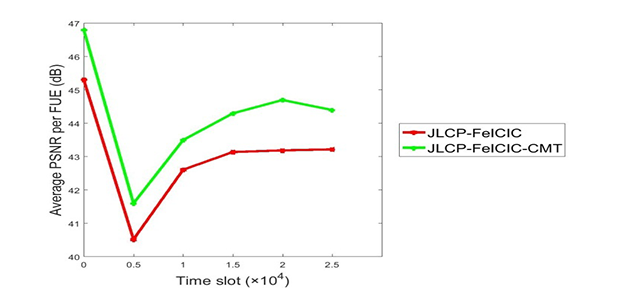


Indian Journal of Science and Technology
DOI: 10.17485/IJST/v13i41.1618
Year: 2020, Volume: 13, Issue: 41, Pages: 4287-4296
Original Article
P Madhu1∗, V Sujatha2
1 Research Scholar, Department of Computer Application, CMS College of Science & Commerce, Coimbatore, Tamilnadu, India
2 Dean Administration, Associate Professor, Department of Computer Application, CMS College of Science & Commerce, Coimbatore, Tamilnadu, India
∗ Corresponding author:
[email protected]
Received Date:24 August 2020, Accepted Date:28 October 2020, Published Date:24 November 2020
Background: The most challenging problem in femtocell networks is alleviating the Inter-Cell Interference (ICI) between the macro and femtocells while broadcasting the video streams in the Heterogeneous Networks (HetNets). It degrades the spectral efficacy and throughput significantly. To alleviate this problem, a Joint dynamic Layer, Channel and Power assignment with Further enhanced ICI Coordination (JLCP-FeICIC) method was recommended to assign the resources within every User Equipments (UEs) and enhance the throughput in a two-tier HetNets. Nonetheless, it schedules only the Cell Range Expansion (CRE) UEs of femtocells while the center UEs are not assigned and so the fairness of Resource Block (RB) allocation is reduced. Objective: Therefore in this study, JLCP-FeICIC is further enhanced with the Coordinated Multipoint Transmission (CMT) method (JLCP-FeICIC-CMT) for maximizing the efficiency of the HetNetcenter UEs. Methods: In this method, RBs are assigned by a primary scheduler. Also, the UE is detected in every eNodeBs (eNBs) according to the determination of the interference from the adjacent cells. Then, the Modulation and Coding Scheme (MCS) level is selected in all eNBs for UEs with and without the support of CMT according to the interference-free RB allocation. So, a higher level of spectral efficiency is achieved for corresponding RBs. Findings: Finally, the experimental results exhibit the JLCP-FeICIC-CMT achieves an increased efficacy than the JLCP-FeICIC.The efficiency is analyzed based on the average of Peak Singal-to-Noise Ratio (PSNR) per Femtocell UE (FUE), utility, monetary cost, and Playback Interruption Rate (PIR).
Keywords: Femtocell network; HetNet; JLCPFeICIC; coordinated multipoint transmission; modulation and coding scheme
© 2020 Madhu & Sujatha. This is an open-access article distributed under the terms of the Creative Commons Attribution License, which permits unrestricted use, distribution, and reproduction in any medium, provided the original author and source are credited. Published By Indian Society for Education and Environment (iSee).
Subscribe now for latest articles and news.